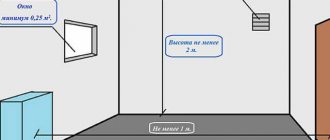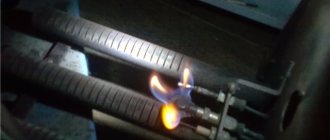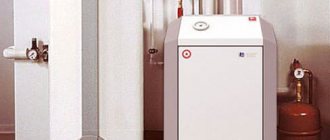A single-circuit or double-circuit gas boiler is equipment that makes our life in a house or apartment more comfortable. Manufacturers now produce a huge range of gas appliances, differing in power, functionality, and installation method. However, even the most expensive and reliable models can fail. Agree, it’s not very pleasant to be left on a winter evening without heat and hot water.
Having analyzed the possible causes of breakdowns of gas equipment, we came to the conclusion that most often malfunctions occur due to the fact that the pressure in the expansion tank of a gas boiler or water heater is incorrectly adjusted. In this article we will figure out why an expansion tank is needed, how to pump air into it yourself and set the optimal pressure.
Why is an expansion tank needed?
When heated, water tends to expand—as the temperature rises, the volume of the liquid increases. Pressure begins to increase in the heating system circuit, which can have a destructive effect on gas equipment and the integrity of the pipes.
The expansion tank (expanzomat) serves as an additional reservoir into which excess water formed as a result of heating is pressed out. When the liquid cools and the pressure stabilizes, it returns through the pipes back into the system.
The expansion tank acts as a protective buffer; it dampens water hammer, which constantly forms in the heating system due to frequent turning on and off of the pump, and also eliminates the possibility of air locks.
To reduce the likelihood of air locks and prevent damage to the gas boiler due to water hammer, the expansion tank should be mounted in front of the heat generator, on the return line
There are two different types of damper tanks: open and closed types. They differ not only in design, but also in the method and location of installation. Let's look at the features of each of these types in more detail.
Open expansion tank
An open type tank is mounted at the top point of the heating system. The containers are made of steel. Most often they have a rectangular or cylindrical shape.
Typically, such expansion tanks are installed in the attic or attic. Installation under the roof is possible. It is imperative to pay attention to the thermal insulation of the structure
The structure of the open-type tank has several outlets: for water inlet, cooled liquid outlet, control pipe inlet, and also an outlet pipe for coolant discharge into the sewer. We wrote more about the structure and types of an open tank in our other article.
Open tank functions:
- controls the coolant level in the heating circuit;
- if the temperature in the system has decreased, it compensates for the volume of coolant;
- when the pressure in the system changes, the tank acts as a buffer zone;
- removes excess coolant from the system into the sewer system;
- removes air from the circuit.
Despite the functionality of open expansion tanks, they are practically not used anymore. Since they have many disadvantages, for example, the large size of the container, the tendency to corrosion. They are installed in heating systems that operate only with natural water circulation.
Closed expansion chamber
In closed-circuit heating systems, a membrane-type expansion tank is usually installed; it is optimally suited for any type of gas boiler and has many advantages.
An expansomat is a hermetic container, which is divided in the middle by an elastic membrane. The first half will contain excess water, and the second half will contain regular air or nitrogen.
Closed expansion tanks for heating are usually painted red. There is a membrane inside the tank; it is made of rubber. A necessary element to maintain pressure in the expansion tank
Compensation tanks with a membrane can be produced in the form of a hemisphere or in the form of a cylinder. Which is quite suitable for use in a heating system with a gas boiler. We recommend that you familiarize yourself in more detail with the installation features of closed tanks.
Advantages of membrane types of tanks:
- ease of self-installation;
- corrosion resistance;
- work without regular addition of coolant;
- lack of contact of water with air;
- performance under high load conditions;
- tightness.
Gas attachments are usually equipped with an expansion tank. But the additional tank is not always configured correctly from the factory and can immediately start heating.
Two ways to drain water from the boiler, pros and cons
So, there are two ways to drain the water from the boiler without flooding everything around it.
Method one
For example, through a safety valve, one that is designed to relieve excess pressure.
Relief valve
This is convenient because the relief valve is located in the front part of the boiler, and it is easy to access; you just need to place some container and turn the red handle of the tap to release the water.
It also has a nozzle that can be easily rotated to direct the draining water into the container. But it’s even better to do all this through a hose, and you don’t have to pull it onto the nozzle, you can just hold it. But this method also has a drawback. The fact is that this tap is usually at rest for a long time and its rubber gasket is deformed when it is strongly pressed against the ribs of the body. Therefore, if this whole thing gets started, then there is a high probability that after filling the boiler with water, the relief valve will begin to leak and there will be a need to disassemble, repair or replace it.
Method two
Use the tap to drain the water. It does not have the disadvantage described above, since it is intended specifically for this purpose, but the disadvantage is the location of this very crane. It is located at the rear wall of the boiler, from below and is not always accessible, since boilers are often installed in various cabinets.
Water drain tap
In this case, you will have to use a hose unless you want to drain the water onto the floor. But it is also not necessary to pull the hose tightly onto the outlet; simply loosen the faucet valve (the ribbed part) by rotating it counterclockwise, and simply direct the water through the hose into the container, holding the hose with your hand.
Drain the water using a hose
Well, now that the work is completed, do not forget to close the drain valve before filling the circuit with water!
Source
Air pressure in the expansion tank
The air or nitrogen pressure in the expansion tank will not be the same for different gas boilers; it all depends on the type of equipment and design features. The standards are indicated by the manufacturer in the product passport.
Typically, the pressure in a new damper tank is 1.5 atm. But this setting may not be suitable for a specific heating system. Factory settings are easy to reset. For these purposes, there is a special fitting in the expansion tank housing (for some manufacturers this is a spool valve for pumping), through which the air pressure is adjusted.
The nipple is located on the side of the air chamber of the cylinder. With its help you can release excess pressure or, conversely, pump up the tank
For the normal functioning of a gas boiler, it is necessary that the pressure in the membrane tank be 0.2 atm less than in the system itself. Otherwise, the heated water that has increased in volume will not be able to enter the container.
In small houses and apartments for closed heating systems, the pressure in the expansion tank is usually acceptable in the range of 0.8-1.0 bar (atm). But not less than 0.7 bar, since many gas boilers have protection and the device simply will not turn on.
The tank pressure level should be checked annually. If pressure surges are noticed in the heating system, it means that air has come out of the damper tank and needs to be pumped up.
Hydraulic tank maintenance rules
A routine inspection of the expansion tank consists of checking the pressure in the gas compartment. It is also necessary to inspect the valves, shut-off valves, air vent, check the operation of the pressure gauge and water pressure switch. To ensure the integrity of the tank, an external inspection is carried out.
During preventive maintenance, the pressure in the hydraulic tank should be measured and adjusted if necessary.
Despite the simplicity of the device, expansion tanks for water supply still do not last forever and can break. Typical causes are rupture of the membrane or loss of air through the nipple. Signs of breakdowns can be determined by the frequent operation of the pump and the appearance of noise in the water supply system. Understanding how your accumulator works is the first step to proper maintenance and troubleshooting.
How to set the optimal pressure?
The heating system has pressure gauges that control the pressure in the circuit. On the expansion tank itself there is no fitting for installing a measuring device. But there is a nipple or spool for releasing and pumping air or gas. The nipple is the same as on car wheels. Therefore, you can check the pressure level and adjust it using a conventional car pump with a pressure gauge.
Even a simple automobile hand pump with a pressure gauge or an automatic compressor will be suitable for pumping air into the expansion tank.
Before releasing excess pressure or pumping air into the expansion tank of a domestic gas boiler, it is necessary to prepare the system. The car pressure gauge shows the value in MPa; the data obtained must be converted into atmospheres or bars: 1 Bar (1 atm) = 0.1 MPa.
Pressure measurement algorithm:
- Turn off the gas boiler. Wait until water stops circulating through the system.
- In the area with the hydraulic tank, close all shut-off valves and drain the coolant through the drain fitting. For boilers with a built-in tank, the return flow is shut off, as well as the water supply.
- Connect the pump to the tank nipple.
- Pump up the air to 1.5 atm. Wait a little for the remaining water to pour out, then let the air in again.
- Close the valves of the shut-off valves and use a compressor to pump up the pressure to the parameters specified in the passport or to the level - pressure in the system minus 0.2 atm. If the tank is pumped, excess air is released.
- Remove the pump from the nipple, screw on the cap and close the drain fitting. Fill the system with water.
You can check the correct air pressure adjustment when the boiler reaches operating parameters.
If the tank is inflated correctly, then the needle on the pressure gauge of the device during measurement will show a smooth increase in pressure without any jumps or jerks
If the air pressure in the expansion tank is incorrectly adjusted, the entire heating system may malfunction. If the expansion tank is over-inflated, the compensating properties will not work. Because the air will push excess heated water out of the tank, increasing the pressure in the pipes of the heating system.
And with underestimated pressure readings of the compensating tank, water will simply push through the membrane and fill the entire tank. As a result, when the coolant temperature rises, the safety valve will operate.
Sometimes in double-circuit gas boilers, fuses work even if the pressure of the built-in expansion tank is correctly adjusted. This indicates that the tank volume is too small for such a heating system. In this situation, it is recommended to install an additional hydraulic tank.
Connection diagrams for hydraulic tanks
For a hot water supply system, the expansion tank is installed in the section of the circulation line, the suction line of the pump, closer to the water heater.
The tank is equipped with:
- pressure gauge, safety valve, air vent - safety group;
- shut-off valve with a device that prevents accidental shut-off.
In a water supply system where water heating equipment is present, the device takes on the functions of an expansion tank.
Installation diagram in the hot water system: 1 – hydraulic tank; 2 – safety valve; 3 – pumping equipment; 4 – filtration element; 5 – check valve; 6 – shut-off valve
In the cold water system, the main rule when installing a hydraulic accumulator is installation at the beginning of the piping, closer to the pump.
The connection diagram must include:
- check valve and shut-off valve;
- security group.
Connection schemes can be very different. The connected hydraulic tank normalizes the operation of the equipment, reducing the number of pump starts per unit of time and thereby extending its service life.
Installation diagram in a cold water system with a well: 1 – tank; 2 – check valve; 3 – shut-off valve; 4 – relay for pressure regulation; 5 – pumping equipment control device; 6 – security group
In a scheme with a booster pumping station, one of the pumps runs constantly. This system is installed for houses or buildings with high water consumption. The hydraulic tank here serves to neutralize pressure surges, and to accumulate water, a container of as large a volume as possible is installed.
Purpose of an additional tank of a double-circuit boiler
As a rule, built-in compensation tanks in gas boilers have a volume of about 6-8 liters. They are designed to compensate for the expansion of 120 liters of coolant circulating in the heating system. Under normal operating conditions, such an expansion tank is enough for a small apartment or house.
When installing radiators of non-standard shape and size, the heating system must be equipped with an additional expansion tank. Because these batteries hold more water
If the heating area is large, heated floors are installed or there are many radiators in the rooms, the volume of the standard built-in tank will be small, since more water is used.
When heated, excess coolant completely fills the tank. And since there is no free space left in the tank, the water pressure increases in the heating system itself and an emergency release occurs by the safety valve. After this, it is unlikely that the gas boiler will be able to start working automatically.
To avoid such negative consequences, an additional expansion tank with a membrane is installed in the heating system in a design for a double-circuit gas boiler. When the standard tank is completely filled, the water goes into the reserve hydraulic tank. After cooling, the liquid returns to the radiators.
Six myths about hydraulic accumulators
Many people have misconceptions about hydraulic accumulators. It is not clear where they came from, but they definitely interfere with the normal operation of the device.
So, what are the most popular myths about hydraulic tanks:
- the larger the tank, the better;
- all hydraulic accumulators are completely identical;
- it is necessary to install an air vent;
- the hydraulic accumulator must be blue;
- in winter it is necessary to bleed air;
- If there are problems with the membrane, you need to completely change the tank.
To expose all these myths, you need to consider and understand each of them in detail. It's actually simple.
The bigger the tank, the better
Why is this better? Maybe for a pump or accumulator? Or maybe for the reliability of the entire system? There's really no point in buying a large tank. It has a much higher price, is more difficult to maintain and takes up a lot of space.
Calculation of expansion tank volume
It is not difficult to ensure stable operation of the heating system; the main thing is to correctly select the volume of the compensation tank. The volume of the expansion tank should be calculated taking into account the most intensive operating mode of the gas boiler. When heating is first started, the air temperature is not yet very low, so the equipment will operate at an average load. With the arrival of frost, the water warms up more and its quantity increases, requiring more additional space.
It is recommended to select a tank with a capacity of at least 10-12% of the total amount of liquid in the heating system. Otherwise, the tank may not be able to cope with the load.
You can independently calculate the exact capacity of the expansion tank. To do this, first determine the amount of coolant in the entire heating system.
Methods for calculating the volume of water in the heating system:
- Completely drain the coolant from the pipes into buckets or other containers so that the displacement can be calculated.
- Pour water into the pipes through the water meter.
- The volumes are summed up: the capacity of the boiler, the amount of liquid in the radiators and pipes.
- Calculation based on boiler power - the power of the installed boiler is multiplied by 15. That is, for a 25 kW boiler you will need 375 liters of water (25 * 15).
After the amount of coolant has been calculated (example: 25 kW * 15 = 375 liters of water), the volume of the expansion tank is calculated.
There are many methods, but not all of them are accurate and the amount of water that fits into the heating system can be much greater. Therefore, the volume of the expansion tank is always selected with a small margin
The calculation methods are quite complex. For one-story houses, use the following formula:
Expansion tank volume = (V*E)/D,
Where
- D – tank efficiency indicator;
- E – liquid expansion coefficient (for water – 0.0359);
- V is the amount of water in the system.
The tank efficiency indicator is obtained using the formula:
D = (Pmax—Ps)/(Pmax +1),
Where
- Ps =0.5 bar is an indicator of the charging pressure of the expansion tank;
- Pmax is the maximum pressure of the heating system, on average 2.5 bar.
- D = (2,5-0,5)/(2,5 +1)=0,57.
For a system with a boiler power of 25 kW, an expansion tank with a volume of: (375*0.0359)/0.57=23.61 l will be required.
And although a double-circuit gas boiler already has a built-in 6-8 liter tank, looking at the calculation results, we understand that stable operation of the heating system will not be possible without installing an additional expansion tank.
Conservation of the Abyssinian well
The liquid in Abyssinian soil is usually lower than the point to which the ground freezes. Therefore, nothing will happen to the well in winter. The main thing was to take care of draining the water from the pipes and covering the mouth.
So what to do:
- remove the pump and hoses, drain the water from them and put them in a warm place;
- remove water from the pipes and blow them with air;
- screw the head onto the thread that was made in advance;
- cover the head with film.
It is also recommended to pour a solution of bleach (40 grams) and water into the well. For every meter of well you need a bucket of this solution.











